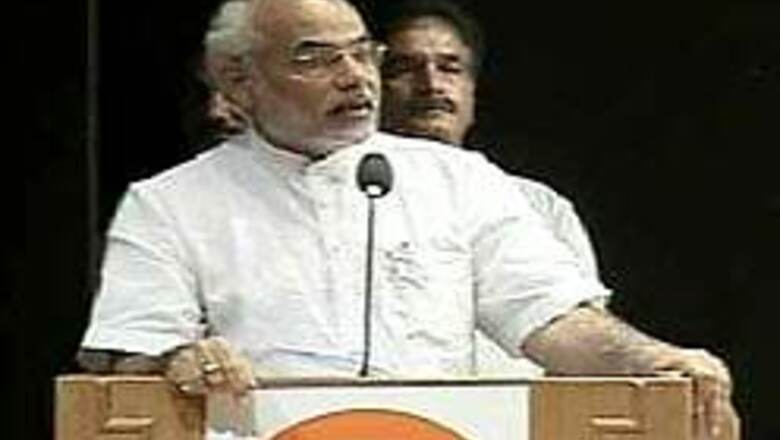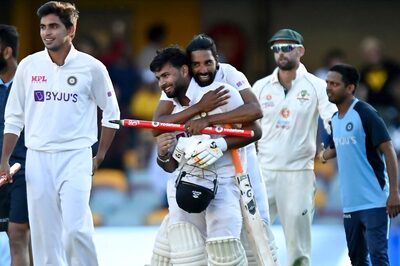
views
Ahmedabad: His opponents sought to pin him down on communal issues but Chief inister Narendra Modi had the last laugh as he kept harping about the developmental work he had done during his entire election campaign.
Congress President Sonia Gandhi's controversial remark describing the state government as ''merchants of death'' also does not seem to have worked in favour of her party as the BJP appeared to have secured the votes of even the minorities in South and Central Gujarat.
A recent Reserve Bank of India report says that Gujarat under Mr Modi was the favourite destination for investments in the country in 2007. ''It ranks first on the list with proposed investments of Rs 73,170 crore in 86 projects, accounting for 25.8 per cent of the total. At a time when state after state is grappling with a deteriorating industrial relations situation, Gujarat is ranked lowest in man-days lost in 2006, better than Maharashtra and Tamil Nadu.''
It said while Nandigram and Singur were on a boil this year, there has not been a single major and dispute in Gujarat during the past few years. In the last six years, the Modi government has worked on 72 initiatives, including public-private participation in health care, adult education, urban development, rural infrastructure and farming and gender equality, apart from encouraging investments into the state.
The state's Plan expenditure has grown at an annualised rate of 32.25 per cent between 2001-02 and 2006-07 and its non-Plan expenditure for the same period reduced by 8.98 per cent. The annualised growth in revenue expenditure over the period was 4.75 per cent, while revenue eceipts grew 13.66 per cent, indicating the state has not indulged in financial profligacy.
Mr Modi has cut energy subsidies from Rs 3,536 crore in 2001-02 to Rs 1,747 crore in 2006-07. The average cost of Gujarat's debt is projected to come down from 12.1 per cent in 2001-02 to 9.33 per cent in 2006-07. The state has moved from a revenue deficit of Rs 4,037 crore in 2004-05 to a revenue surplus of Rs 1,803 crore in 2006-07.
''The government had set a target of fiscal deficit of not more than three per cent by 2008-09. It achieved the target three years in advance by achieving a fiscal deficit of 2.89 per cent in 2005-06,'' said a senior government official.
The Modi administration has also turned around some ailing state-owned units like Gujarat Alkali and Chemicals Ltd and Gujarat State Fertilizer and Chemicals Ltd by avoiding political appointees and bringing efficient bureaucrats at the helm.
It was during his tenure that the Gujarat State Petroleum Corporation struck gas in the Krishna-Godavari basin. His political rivals laughed at him when Modi initiated the reforms in the power sector. Gujarat was the first state to successfully carry out the unbundling of its state electricity board in April 2005. As a result, the Gujarat Electricity Board turned the corner and reported a profit of Rs 219 crore in 2006-07.
A study conducted by the CII and the Institute of Rural Management on the Jyotigram Yojana, the state government's rural electrification scheme which promises 24-hour, 3-phase electricity to villages, says there is an increase in the level of average employment and reduction in migration from rural areas by 33 per cent.
On the urban development front, the state spent Rs 600 crore on 8,500 projects in the span of just one year. Projects such as the Rs 1,200-crore, Sabarmati Riverfront Development project and Bus Rapid Transit System have been hailed by experts. The Riverfront project bagged the Prime Minister's Award for Excellence in Urban Planning and Design in 2003.
While Mr Modi's social initiatives such as the Sagarkhedu Sarvangi Vikas Yojana for the coastal belt and Vanbandhu Kalyan Yojana drew flak from various quarters for being politically motivated schemes, an innovative experiment of evening courts did a splendid job by disposing of over 50,000 cases from November 14, 2006 to March 31, 2007. Data provided by the state government suggests that the Kanya Kelavani Yojana, which focuses on literacy of the girl child, has seen the net enrollment ratio of state go up to 97 per cent. The drop out rate has fallen from 30 per cent to three per cent in five years.


















Comments
0 comment